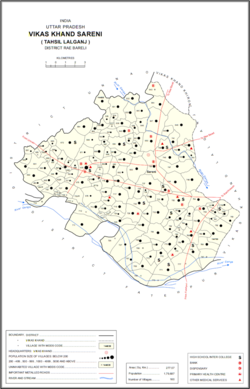Village in Uttar Pradesh, India
Sagar Khera is a village in Sareni block of Rae Bareli district, Uttar Pradesh, India.[2] It is located 14 km from Lalganj, the tehsil headquarters.[3] As of 2011, it has a population of 2,102 people, in 413 households.[2] It has one primary school and a maternity and child welfare centre, and it hosts a weekly haat but not a permanent market.[2]
It is the headquarters of a nyaya panchayat, which also includes 12 other villages.[4]
The 1951 census recorded Sagar Khera as comprising 5 hamlets, with a total population of 787 people (382 male and 405 female), in 163 households and 139 physical houses.[5] The area of the village was given as 434 acres.[5] 60 residents were literate, 54 male and 6 female.[5] The village was listed as belonging to the pargana of Sareni and the thana of Sareni.[5]
The 1961 census recorded Sagar Khera as comprising 4 hamlets, with a total population of 935 people (447 male and 488 female), in 184 households and 166 physical houses.[6] The area of the village was given as 434 acres.[6]
The 1981 census recorded Sagar Khera as having a population of 1,310 people, in 228 households, and having an area of 171.59 hectares.[3] The main staple foods were given as wheat and rice.[3]
The 1991 census recorded Sagar Khera as having a total population of 1,399 people (709 male and 690 female), in 354 households and 352 physical houses.[4] The area of the village was listed as 172 hectares.[4] Members of the 0-6 age group numbered 216, or 15% of the total; this group was 51% male (111) and 49% female (105).[4] Members of scheduled castes made up 30% of the village's population, while no members of scheduled tribes were recorded.[4] The literacy rate of the village was 41% (394 men and 186 women).[4] 449 people were classified as main workers (323 men and 126 women), while 175 people were classified as marginal workers (99 men and 76 women); the remaining 775 residents were non-workers.[4] The breakdown of main workers by employment category was as follows: 262 cultivators (i.e. people who owned or leased their own land); 104 agricultural labourers (i.e. people who worked someone else's land in return for payment); 18 workers in livestock, forestry, fishing, hunting, plantations, orchards, etc.; 3 in mining and quarrying; 2 household industry workers; 1 worker employed in other manufacturing, processing, service, and repair roles; 4 construction workers; 22 employed in trade and commerce; 0 employed in transport, storage, and communications; and 33 in other services.[4]
References

